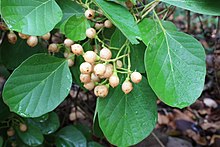Cordia myxa
| Assyrian plum | |
|---|---|
 |
|
| Scientific classification | |
| Kingdom: | Plantae |
| Clade: | Angiosperms |
| Clade: | Eudicots |
| Clade: | Asterids |
| Order: | Boraginales |
| Family: | Boraginaceae |
| Genus: | Cordia |
| Species: | C. myxa |
| Binomial name | |
|
Cordia myxa L. |
|
| Synonyms | |
|
Cordia obliqua |
|
Cordia obliqua
Cordia domestica
Cordia myxa is a species of flowering plant in the borage family, Boraginaceae. It is a medium-sized broad-leaved deciduous tree. Common names include Assyrian plum, lasura, pidar, panugeri, naruvilli, geduri, spistan, burgund dulu wanan and ntege. It is found growing primarily in Asia, as well as, across the globe especially in tropical regions having the right type of geophysical environment. In the Indian subcontinent, it is seen coming up naturally and growing abundantly from Myanmar in the east to Afghanistan in the west. Its habitat starts at about 200 m above mean sea level in the plains and ascends to an altitude around 1,500 m in the hills.
Lasura matures in about 50 to 60 years by when its girth at the breast height is about 1 to 1.5 m. Its bole (main trunk) is generally straight and cylindrical, attaining a height of nearly 3 to 4 m. The branches spread in all directions by virtue of which its crown can be trained into a beautiful inverted dome like an umbrella. When fully grown up, the total height of the tree comes to nearly 10 to 15 m. In less favorable climate and or unfavorable environment, however, it has a lesser growth and may attain a somewhat crooked form. In still worse environments it can even remain a stunted shrub.
The bark of lasura is grayish brown in color with longitudinal and vertical fissures. The tree can be easily identified from a distance by observing the fissures which are so prominent in the bark of the main bole of a tree approaching maturity.
The leaves of lasura are broad, ovate, alternate and stalked with the spread being 7 to 15 cm x 5 to 10 cm. In matter of external appearance these are glabrous above and pubescent below. The young leaves tend to be hairy. The fresh foliage is quite useful as fodder for cattle — more so during grass famines. These are also used for wrapping biddies and cheroots.
Lasura tree flowers during March-April. The inflorescence, mostly terminal, is, white in color. Individual florets are nearly 5 mm in diameter. At places these are somewhat hairy and white. Being a deciduous plant, the species bears male and female flowers on the same tree. The calyx part of an independent flower is about 8 mm long and glabrous, but not pubescent. It splits irregularly at the opening of its bud into flower. The filaments are hairy.
The fruit of lasura start appearing during July-August. It is a kind of a drupe, light pale to brown or even pink in color. The appearance tends to darken when ripening sets in. Being full of viscid glue like mucilage, the pulp is somewhat translucent. When fully ripe the pulp becomes quite sweet in taste and is fully enjoyed by children. The pulp in a half ripe fruit can even be used as an alternative to paper glue in office work.
...
Wikipedia
